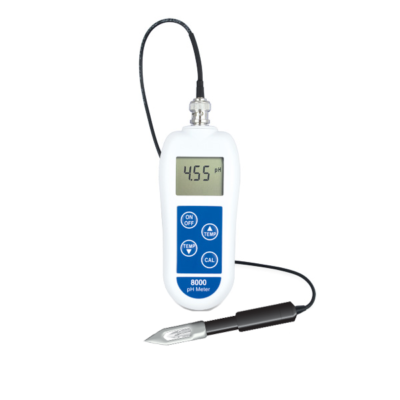Thermometer, Safety, Information
pH Meters in the Meat Industry
It isn’t common knowledge that pH meters are used in the Meat Industry. It is pH that is the link between you as the customer purchasing tasty, good-looking, and juicy meat. This is meat quality. When purchasing a piece of meat, you look for juiciness, taste, price, appearance, tenderness, size, colour, and brand name. Food safety is also a key factor. Factors such as pH, water-holding capacity, colour, and fat are technical attributes that do drive consumer purchasing according to meat scientists.
How does pH influence Meat Quality?
pH measures acidity, and in this case, the level of acidity in the muscle/meat. Living muscle is at a pH of approximately 7.2. When muscle turns to meat, glycogen breaks down to lactic acid. The pH of fresh meat can then range from 5.2 to 6.2. When the pH falls from living muscle to meat the pH level influences the quality characteristics through PSE [Pale, Soft, Exudative] and DFD [Dark, Firm, Dry]. Improper storage and poor preservation create an even lower pH range, which is directly related to colour and texture.
The pH value of meat is evidence of how long the meat will keep. Meat normally reaches its lowest pH value between 18 to 24 hours after slaughter. The value is generally between 5.4 to 5.7. The pH will slowly start to rise steadily again which is the start of decomposition.
Measuring the pH of meat is necessary to maintain quality.
Pork vs Beef
Meat after slaughter reacts differently and here, we can see that beef and pork have different times when it is ready to be used for the preparation of sausages and portioning for sale.
Beef reaches its lowest pH value 18 to 24 hours after slaughter.
Pork reaches its lowest pH value 6 to 10 hours after slaughter.
Example of where pH measurement is critical
Transporting of meat from abattoir to packaging plant. The pH measurement of meat needs to be done before and after transportation. This measurement needs to be accurate. Handling and usage of a pH meter is not difficult. It can prevent the discard of millions of rands worth of stock.
Additional uses of pH measurement
- Testing suitability of meat and meat products on sale or whether they are spoiling.
- Specifying the pH value of the carcass at 1 hour after slaughter and again for vacuum packing while meat is maturing
- Testing if Brine has gone off
Benefits of using pH meters as a Monitoring Tool
Here are 3 key processing areas where you can substantially benefit from pH monitoring:
1. Production Efficiency: the pH of the carcass is directly related to the drip loss amount and the final yield of the meat sold. Meat is greatly influenced by post-mortem pH.
- Meat Quality: pH is a great detector of poor-quality meat. pH information can be used to divide carcasses for more well organised use and monitor process performance.
- Animal Welfare: Carcasses with poor pH may show potential stress-related problems. They can be addressed if they are identified.
Testing the pH of Meat
There are two different ways you can test the pH of meat. Testing solid meat samples and then ground meat samples. If you are needing to test solid meat, a pH meter with a spear-tip electrode is best.
Ground meat is a soft sample so you will be able to use the standard electrode for this.
Calibration is required before taking measurements
It is a set rule with pH meters that you always calibrate the pH meter before taking measurements of the sample. Furthermore, you must always dispose of the sample after testing. Never return the meat sample for processing after testing. The electrode will contaminate the meat because the electrode bulb is made of delicate glass that can break easily. The electrode can also leak reference electrolytes into the meat. The electrode is also a great home for contaminating fungi, bacteria, and viruses which can produce health hazards.
Give us a call if you have any questions or would like us to assist you with a quotation on a pH meter 011 728 6099.


